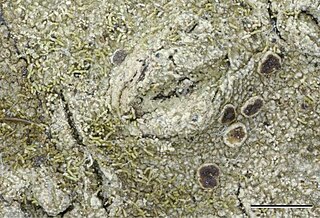
The Arthoniales is the second largest order of mainly crustose lichens, but fruticose lichens are present as well. The order contains around 1500 species, while the largest order with lichenized fungi, the Lecanorales, contains more than 14000 species.

Gassicurtia is a genus of lichenized fungi in the family Caliciaceae.

Bactrospora is a genus of lichen-forming fungi of uncertain familial placement in the order Arthoniales. It was circumscribed by Abramo Bartolommeo Massalongo in 1852.

Enterographa is a genus of lichens in the family Roccellaceae.

Lecanographa is a genus of about 40 species of lichens in the family Lecanographaceae. It was circumscribed in 1994 by José M. Egea and Pilar Torrente, with Lecanographa lyncea as the type species.

Lecanactis is a genus of crustose lichens, commonly called old wood rimmed lichen. The genus was circumscribed in 1855 by German lichenologist Gustav Wilhelm Körber, who assigned Lecanactis abietina as the type species.

Anisomeridium is a genus of lichens in the family Monoblastiaceae. The type species was originally named Arthopyrenia xylogena by Swiss botanist Johannes Müller Argoviensis in 1883; in 1928, Maurice Choisy defined the genus Anisomeridium, designating A. xylogena the type species.

Chrysothrix is a genus of lichen-forming fungi in the family Chrysotrichaceae. They are commonly called gold dust lichens or sulfur dust lichens, because they are bright yellow to greenish-yellow, sometimes flecked with orange, and composed entirely of powdery soredia. Apothecia are never present in North American specimens.

Neoprotoparmelia is a genus of crustose lichens that was created in 2018. It contains 24 tropical and subtropical species that mostly grow on bark. Neoprotoparmelia is in the subfamily Protoparmelioideae of the family Parmeliaceae, along with the morphologically similar genera Protoparmelia and Maronina.

Graphis crebra is a species of corticolous lichen in the family Graphidaceae. It has a pantropical distribution. Like other script lichens, it grows on bark and resembles calligraphy. It can be distinguished from several other similar species by the white pruina (powder) on its apothecial discs.

Herpothallon is a genus of crustose lichens in the family Arthoniaceae. It has about 50 species.
Austrographa is a genus of lichen-forming fungi in the family Roccellaceae. It has three species. The genus was circumscribed in 2013 by lichenologists Laurens Sparrius, John Elix, and Alan Archer, with Austrographa kurriminensis assigned as the type species. The genus had been published invalidly on two separate occasions. All three species in the genus were found in a mangrove stand in Queensland, Australia. The genus was discovered in Australia, and the name Austrographa reflects this.
Vigneronia is a genus of lichen-forming fungi in the family Roccellaceae. It has five species. The genus was circumscribed in 2014 by Damien Ernst, with Vigneronia spieri assigned as the type species. This species, originally described as Schismatomma spieri from collections made in the Galápagos Islands, has since been recorded from mainland Ecuador and the Antilles (Curaçao). The genus is named after Ernst's wife, Nathalie Vigneron, who accompanied him on collecting trips.
Ocellomma is a genus of lichen-forming fungi in the family Roccellaceae. The genus was circumscribed in 2014 by Damien Ertz and Anders Tehler, following a molecular phylogenetic-based revision of the Roccellaceae. The type species, O. picconianum, was originally named Lecania picconiana by Francesco Baglietto in 1862, described from specimens collected in Italy. DNA-based phylogenetic analysis showed that it occupied a distinct genetic lineage, deserving of recognition as a new genus. The genus name Ocellomma alludes to the whitish rims on the small ascomata that contrast with the discs, giving them the appearance of small eyes.
Dirina catalinariae is a species of saxicolous (rock-dwelling), crustose lichen in the family Roccellaceae. It occurs in the southwestern United States, Mexico, and the Galápagos Islands.
Vigneronia spieri is a species of corticolous (bark-dwelling), crustose lichen in the family Roccellaceae. It is found in the Galápagos Islands, mainland Ecuador and the Antilles (Curaçao).
Dictyomeridium is a genus of corticolous (bark-dwelling), crustose lichens in the family Trypetheliaceae. It has eight species.

Fulvophyton is a genus of lichen-forming fungi in the family Roccellographaceae. It has 11 species. Fulvophyton is characterised by its crust-like thallus, which is often pale yellowish-brown in colour. This genus features a photobiont from the green algal genus Trentepohlia and exhibits a unique arrangement of reproductive structures.
Neosergipea is a genus of lichen-forming fungi in the family Roccellaceae. It has four species, all of which are corticolous (bark-dwelling), crustose lichens that are found in the tropical forests of Brazil. This genus is related to the genera Dichosporidium, Enterographa, and Erythrodecton. It distinguishes itself through unique morphological characteristics and certain chemical constituents, in particular, its non-carbonised ascomata and the presence of a vivid orange anthraquinone compound.
Enterographa aldabrensis is a species of corticolous (bark-dwelling), crustose lichen in the family Roccellaceae. It is only known to occur in Aldabra in the Seychelles.











